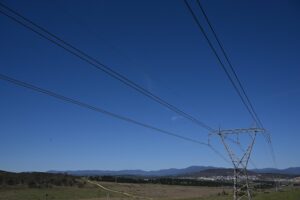The conservative campaign against Australia’s Renewable Energy Target (RET) reached the highest echelons of public office this week, when Prime Minister Tony Abbott joined the throng blaming renewable energy for rising electricity bills.
 “We’ve got to accept … that in the changed circumstances of today, the renewable energy target is causing pretty significant price pressures in the system,” the Guardian quoted him as saying. “Cheap energy ought to be one of our comparative advantages …. I mean, this country ought to be an affordable-energy superpower.”
“We’ve got to accept … that in the changed circumstances of today, the renewable energy target is causing pretty significant price pressures in the system,” the Guardian quoted him as saying. “Cheap energy ought to be one of our comparative advantages …. I mean, this country ought to be an affordable-energy superpower.”
I hate to break the news to you, great leader, but there is no longer any such thing as cheap fossil fuel energy in Australia – the gas export boom and greedy network operators have put paid to that. Sure, you can shovel coal into a brown coal generator in the Latrobe Valley for $4 a tonne, but years of gold-plating in the networks and the profit margins for retailers who package up the bills means that those electrons cannot be delivered to suburban households for much less than the cost of a diesel generator at a remote mine. The grid is failing its purpose.
Mostly, the marginal cost of electricity generation is set not by brown coal but by higher price fuels, and particularly the price of gas-fired generators. Australians this week got a taste of what Origin Energy CEO Grant King meant when he said, earlier this year, that “there is no such thing as cheap gas.”
Queensland households were told this week that their electricity bills were going to rise by another 13.5 per cent in 2014/15. Like Abbott, the conservative state government blamed all things carbon and green energy, particularly solar.
But the biggest single contributor to the increased bills was a rise in gas prices, caused by the massive LNG boom in Queensland. Just the annual rise in bills caused by this surging gas price was more than the total cost of the renewable energy target, which in Queensland accounts for less than 2 per cent of the electricity bill. (In other states it is barely more than 1 per cent). Ironically, the rise in the gas component would have been greater were it not for the dampening effect on wholesale prices by wind and solar energy.
As sure as night follows day, those rising gas prices will flow through to consumers in other states, and will accelerate as gas prices double, and possibly triple, as many analysts suggest, once the LNG export market gets into full swing. Australia is trying to make a motza by selling its huge gas reserves to Japan, China and anyone else who will take it. And Australian consumers will have to pay the same price.
Abbott says that he will chair a panel that will look at how to “significantly” lower the price of electricity for consumers. He will quickly find out that the only option is to cut the value (and so the returns and the bill component) of network assets, a decision that his energy minister Ian MacFarlane’s proposed energy white paper appears to have already ruled out. (It would, after all, cause wails of protest from the conservative governments that own these assets in Queensland, NSW and WA).
There is growing evidence, however, that Australian consumers will not be easily conned by politicians and their advisors about the cost of energy, and renewables in particular. It was interesting to note that, even when News Ltd meekly repeated Newman’s renewables attack, it was shouted down by the majority of comments on their website, who called it for the nonsense it is.
One quarter of households swap suppliers each year looking for a cheaper offering – and so they should, because every household in states like Queensland and NSW is billed an extra $100-$140 a year just so retailers have the “headroom” to do so. (So in effect, your discount is subsidised by higher bills to your neighbour. The discounts don’t cost the retailers a cent.)
More importantly, more than one million Australian households now have rooftop solar, a number that is likely to double or even treble before the end of the decade, putting yet more pressure on networks to justify their past investment and the returns that are hard-wired into bills.
It is interesting to note that, in Germany, the push for the energy transition now underway in the most dramatic of circumstances came not from politicians who led from the front, but from politicians who were forced to follow.
It was a movement sparked by the German population’s distrust of nuclear, their suspicion of centralised generation, and their reluctance to rely on expensive imported fuels (mostly Russian gas).
Now the German energy transition – called the Energiewende – is underway and it is unstoppable. Towns and cities are buying back their grids because they no longer trust the big utilities to do the right thing.
As Germany’s new junior minister responsible for this transition, Rainer Baake, told RenewEconomy last month, no party dared to go to the recent German polls questioning the Energiewende. The party least enthusiastic lost all its seats in parliament. The centre-right CDU party of Angela Merkel and the left of centre SDP have formed a grand coalition that has unveiled even more ambitious “renewable energy” corridors, that will see Europe’s biggest economy powered 60 per cent by renewables within two decades.
Australia is already moving down the path to its own, people-driven Energiewende. Those one million solar households (more than two million voters) now have 3GW of capacity on their rooftops. Price falls in battery storage will increase the ability of households to manage their own production – new financing offers will bring these options to the lowest income households and to renters and apartment dwellers.
The other ingredients that sparked the Germans to take action now exist in Australia: expensive gas, dirty coal, and utilities who are no longer trusted to do the right thing.
The Queensland and WA governments are the most vocal opponents of renewable energy and rooftop solar. Yet it is they who are managing what are quite possibly the most unsustainable fossil fuel grids in the world. Both states rely hugely on subsidies (totaling $1 billion a year) to deliver the fossil fuel to the socket, and the government-owned entities still make losses.
The fact that they are trying to stop the rollout of solar and storage, and extend the life of moribund assets, beggars belief. The bizarre decisions taken in WA, where the government proposes to extend the life of its main mis-firing coal-fired generator, to subsidise the construction of diesel-fuelled peaking plants that may never be switched on, to retrospectively change solar tariffs, and declare it is no longer interested in large-scale renewable energy development, is just a taste of the extraordinary decisions being made.
For a long time, the incumbent utilities have relied on the mantra that confusion equals profit, and it is only the complexity of Australia’s electricity sector – and the obfuscation of the incumbents and the regulators who have protected them – that hides this idiocy from the public eye. The “headroom” cited above is a perfect example of that, but the public is slowly wising up, and becoming increasingly of the mind to take matters into its own hands.
Needless to say, the network operators and generators are terrified. And so they should be; as long as they are managed and advised by people transfixed by the past and blind to the future. Studies such as that conducted by the CSIRO suggest that nearly half of Australia’s households could cut themselves off from the grid if the networks and their government owners get too greedy and resist, rather than adopt, new technologies and new ways of doing business.
Sadly, the policy makers and asset owners are being egged on by ideologues and ageing die-hards, who describe such scenarios painted by the CSIRO as “science fiction”, and who are convinced that future energy grids will look like they did 50 years ago, and whose only motivation appears to protect short-term business interests.
UBS this week made it clear what’s at stake for incumbent utilities in Australia, Europe and north America, and how they face a “perfect storm” from renewables and storage. It recommended the incumbents were better off embracing rather than resisting new technology, and that includes renewables, both large-scale and small-scale.
Alan Pears, from Melbourne’s RMIT, had a similar message. In a submission to the AEMC’s market review, Pears asked what a socially responsible network operator might do. And he answered: It would support measures such as demand management, reward rather than penalise those who installed small-scale renewable energy systems and storage, incorporate storage into the network and cut fixed charges, which penalise low-income and small households the most.
He noted that network operators had lost their presumed position as natural monopolies. They now compete with an increasing range of distributed energy, energy efficiency and demand management options. While these options rarely allow a consumer to cost-effectively disconnect completely from the grid, they are moving in that direction. Because of this, networks are not entitled to recover all their costs, and society is entitled to claw back some of their historical profits.
The other issue is in large-scale generation. Currently, the renewable energy target is the most effective means of reducing emissions. Wind energy is, and solar soon will be, cheaper to build than new fossil fuel generation. The incumbents want to stop any new generation for the simple reason that it will reduce their own profits, because they have already built too much.
Reports such as those from UBS, the CSIRO, and any number of international studies, including by former US energies secretaries, insist that only by changing and embracing cheaper renewables will current networks and generators survive, and avoid passing massive sunk costs on to consumers. Managing this will be the real test of Abbott’s review. It requires more than an ideological and self-interested rant against green energy.








